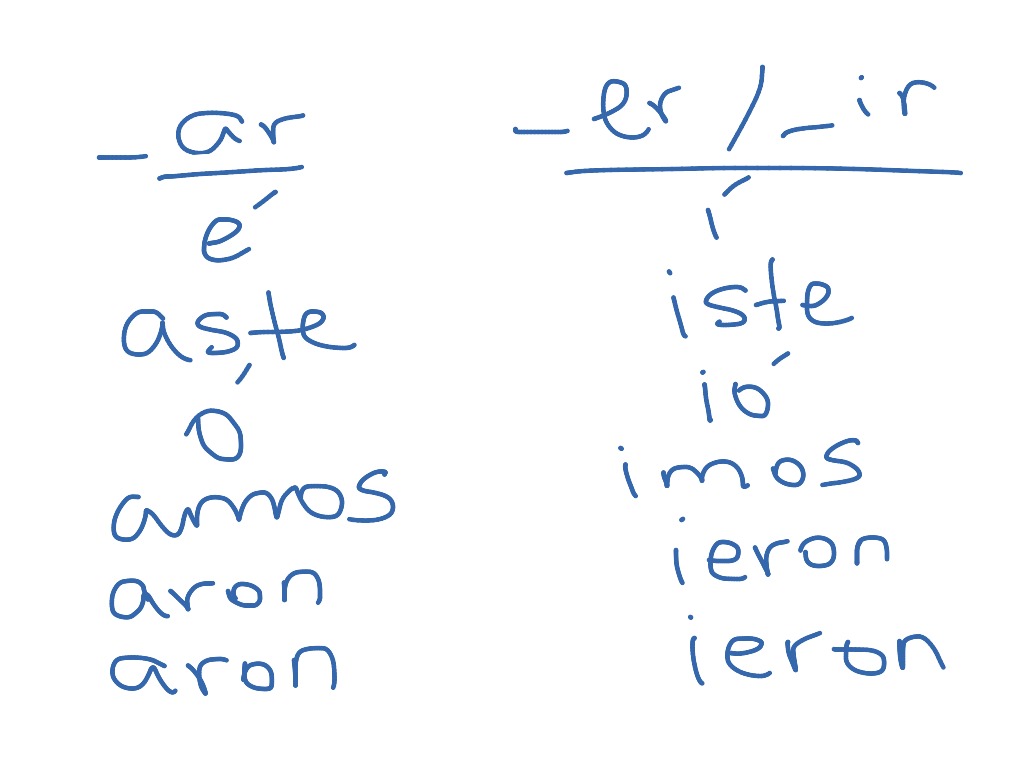
But with some memorization and practice, you’ll be able to conjugate irregular verbs just as easily. Irregular verbs in Spanish don’t follow the regular conjugation pattern. Now that you understand how regular -AR verbs work, it’s time to meet irregular -AR verbs. Hungry for more? Check out the most common Spanish verbs across the -AR, -ER, and -IR categories. Here is a list of the most common regular -AR verbs in Spanish that are essential to know for every Spanish speaker.

When conjugating them in the present or simple past tense, their verb stems will always stay the same, and their endings will always follow the same pattern outlined in the charts above. In Spanish, regular verbs are just that-regular. Just like in the present tense, the verb stem ( trabaj- in trabajar) never changes in the past tense for regular -AR verbs. Here is what the verb trabajar looks like in the simple past tense: yo To conjugate Spanish -AR verbs in the simple past tense, replace the “- ar” ending with the following verb endings, depending on the subject. In English, verbs in the simple past tense typically have “-ed” endings, like “walked” or “talked.” The simple past, or preterite, tense is used to talk about things that have already happened. This is especially common in spoken Spanish, and practicing it can help you sound more like a local in daily conversations! Conjugate regular -AR verbs in simple past tense In Spanish, if it’s obvious who the subject is, pronouns are often omitted or only used for emphasis. In the second sentence, the pronoun ( nosotros) is unnecessary because the conjugated verb ending clearly indicates who is doing the action. This is true with all regular Spanish -AR verbs. *Vosotros and vosotras are only used in Spain.įor example, here is what the verb trabajar (to work) looks like in the present tense: yoĪs you can see, the verb stem ( trabaj- in trabajar) never changes, while the verb ending changes depending on the subject. Vosotras (you all, feminine and informal)* Vosotros (you all, masculine and informal)* To conjugate Spanish -AR verbs in the present tense, replace the “- ar” ending with the following verb endings, depending on the subject. The present tense indicates that something is currently happening or regularly happens. The tense of a verb tells you when the action is taking place. Conjugate regular -AR verbs in present tense
PRETERITE ENDINGS SPANISH AR HOW TO
Let’s take a closer look at how to conjugate -AR verbs in the present and preterite tenses. Conjugation is how the form of a verb changes to reflect the subject and indicate when something happens. When you see a verb with one of these endings, they are in their infinitive, or basic, form.īut if you want to express that these actions are done by different subjects (you, he, they, etc.) or in different tenses (present, past, future, etc.), the Spanish verbs need to be conjugated.

In Spanish, the majority of verbs have one of these three endings: A quick introduction to Spanish verbs and conjugation

Ready to add the most common and useful Spanish -AR verbs to your vocabulary? Let’s dive in. Once you learn how to conjugate a few Spanish -AR verbs, you’re already well on your way to conjugating 80% of the verbs in Spanish! For Spanish learners, knowing how to use -AR verbs is essential for feeling comfortable in real-life conversations. According to the Royal Spanish Academy, more than 80% of verbs in Spanish end in -AR.


 0 kommentar(er)
0 kommentar(er)
